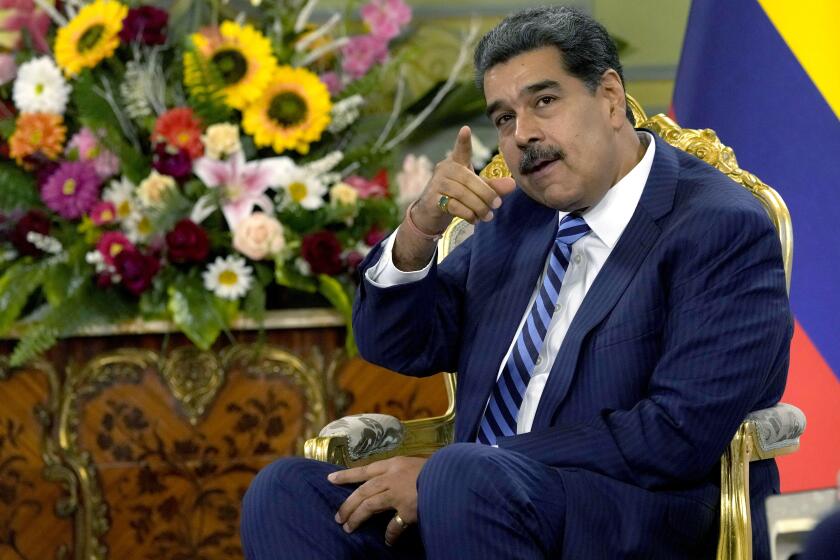Why Nicolás Maduro appears 13 times on Venezuela’s presidential ballot

- Share via
CARACAS, Venezuela — His smile is confident, his hair well-combed and his eyes are squinting slightly: The first candidate you’ll likely see on the ballot in Venezuela’s upcoming presidential election is incumbent Nicolás Maduro.
Unlike some of his nine challengers, Maduro shows up not once or twice, but a whopping 13 times on the ballot — and he’s certain to catch the voters’ attention.
Each time, it’s for one of the several political groups he is representing in the highly anticipated July 28 presidential election. Maduro takes up the entire first of the ballot’s four rows while the rest of the candidates’ photos are sprinkled here and there, including that of former diplomat Edmundo González Urrutia, the only contender with real chances of denying the president a third term.
Still, the sheer number of Maduro’s images appearing on the ballot belies the seriousness of the moment.
Venezuela faces its toughest electoral test in decades. The outcome could give Maduro another six years in power or end the self-described socialist’s policies that once successfully boosted anti-poverty programs but whose sustained mismanagement later pushed the country into an ongoing economic crisis.
As the election approached, the South American country’s government intensified efforts to curtail democratic freedoms with threats, surveillance and harassment a United Nations-backed panel investigating human rights violations in Venezuela found last year.
Venezuela’s electoral rules allow for candidates’ pictures to appear on the ballots — the electronic ones within Venezuela and printed for those voting abroad — as many times as the number of parties that support them. This year’s ballot has 38 pictures, each with every candidate’s name and party underneath.
President Nicolás Maduro holds a rally in Caracas as he announces his candidacy for a third term, while opponents struggle to register another candidate.
Seasoned Venezuelan voters are also used to seeing many candidates on the touchscreens used in the South American country’s elections.
But for some, that many photos could be confusing.
“I get dizzy when I see Maduro so many times on that card, but I know that the danger is in the candidates who do not represent us,” said Sonia Guevara, a 38-year-old office worker, referring to some opposition candidates who are seen as close to the government.
Such an example is the case of Luis Martínez, the candidate from “Acción Democrática” — Democratic Action party, or AD for short — a traditional opposition group whose leadership was suspended months ago by the Maduro-loyal top court.
Martínez decided not to support González, the contender of the opposition’s Unitary Platform coalition.
“This is confusing. I have had to explain to my mother many times that the AD on the card is not the AD she always votes for,” Guevara said. “My mom is 71 years old, and I tell her not to vote for AD this time.”
The U.N.-backed panel says human rights violations to curtail democratic freedoms in Venezuela have intensified ahead of the 2024 election.
González is featured three times on the ballot. Martínez, who is considered a government ally, shows up six times.
The number of eligible voters ahead of this month’s election is estimated to be around 17 million. Another 4 million Venezuelans living abroad are registered to vote, but only about 69,000 met the government-set requirements to cast ballots overseas. Costly and time-consuming government prerequisites to register, lack of information and a mandatory proof of legal residency in a host country kept many migrants from signing up to vote.
Francisco Maldonado, a 50-year-old merchant in Caracas, is ready to vote.
“At this point, I think we all know who we are going to vote for, but more than ever we have to be careful, the same care we have when we use an ATM,” Maldonado said. “We cannot make a mistake when marking.”
Venezuela’s exact population is unclear as the last census in the South American country was conducted in 2011. At the time, it concluded there were 27.2 million people — but since the country’s political, economic and social crisis over the last decade, more than 7.7 million have left.
Laura Dib, Venezuela program cirector at WOLA, a Washington-based nongovernmental organization focused on human rights in the Americas, said that even if it’s common that a candidate’s face is repeated on the ballot, being 13 times on it, makes Maduro “visually the easiest to identify.”
Considering that the opposition faction supporting González has no access to official media in Venezuela, Dib said that “the opposition has a harder time educating voters on how to vote.”
She also noted there are other confusing matters — some parties are using the same colors on the ballot as those supporting Maduro. And one candidate from an opposition faction was allowed to use the same color as the main opposition candidate group.
That, Dib said, “also creates confusion and it violates the rules of the CNE,” she said, referring to the acronym in Spanish for the national electoral council.
Additionally, the electoral law allows parties to substitute candidates 10 days before election day, although that change may not be reflected on the ballots, which have already been programmed on the electronic machines or printed for the vote abroad.
If people vote for a candidate who has been replaced, Dib said, “those votes casted will be null.”
Rueda writes for the Associated Press. AP writer E. Eduardo Castillo in Mexico City contributed to this report.
More to Read
Sign up for Essential California
The most important California stories and recommendations in your inbox every morning.
You may occasionally receive promotional content from the Los Angeles Times.











